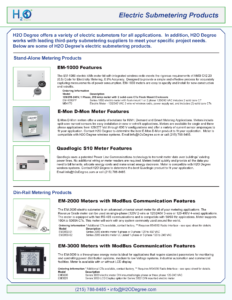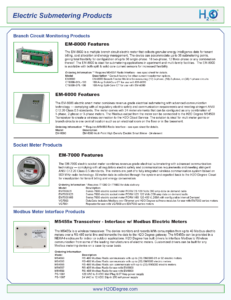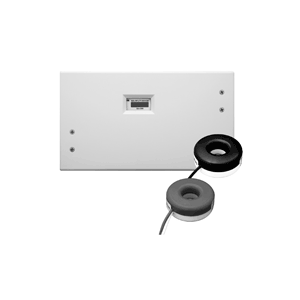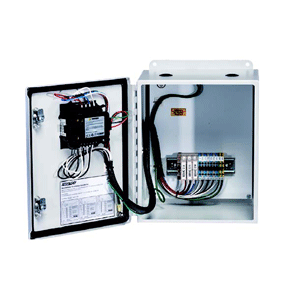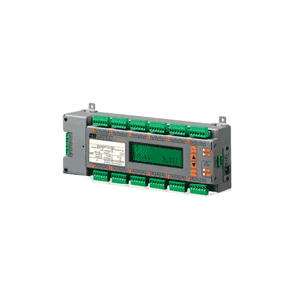
How Does Electric Submetering Benefit You?
H2O Degree offers a variety of electric submetering solutions and utility billing solutions for multi-family residential and commercial facilities. Our electric metering products will help improve utility management in your facility. Whether you are billing tenants for their usage, managing common areas or implementing conservation programs such as LEED or SB7, H2O Degree has a wireless solution that will meet your needs.
We have a comprehensive inventory of electric metering products to support your energy management goals.
Scroll down to the links below to view the electric metering product guides, or click the product photos to see details on each electric metering product.
Product Guides
Our electric metering products are a testament to our commitment to innovation in energy management. From submeters that provide granular data on electricity usage to networked systems offering real-time monitoring and reporting, we’re confident that our offerings can meet your unique energy management needs.
And if you’re looking for the best ways to use and maximize your electric metering and submetering systems, H2O Degree has the information you need. Explore our product guides below to learn more about how our technologies work, their benefits, and how they can be integrated into your properties.
Electric Submetering Products
Our electric metering products are a testament to our commitment to innovation in energy management. From submeters that provide granular data on electricity usage to networked systems offering real-time monitoring and reporting, we’re confident that our offerings can meet your unique energy management needs.
And if you’re looking for the best ways to use and maximize your electric metering and submetering systems, H2O Degree has the information you need. Explore our product guides below to learn more about how our technologies work, their benefits, and how they can be integrated into your properties.
Additional Information…
How Does Electric Submetering Benefit You?
Our electric metering products have been installed on multi-family residential and commercial facilities for over 10 years providing building owners and tenants alike with an accurate, easy-to-install solution to manage electric utility costs within your facility.
Electric meters install easily in new or retrofit applications to monitor utility energy usage data from individual tenants, common areas or individual pieces of equipment.
This data is easily accessible via a password-protected web portal that can be accessed by both building management and tenants to quickly see exactly when and where electricity is being used.
In addition, H2O Degree electric submetering systems integrate seamlessly with leading RBC (Read, Bill Collect) companies for automated tenant billing solutions.
Electric submetering is especially useful if you are the property manager of a building with multiple tenants, such as a college dorm or apartment building. Not only could this end up saving you money on utility billing, but it will substantially help your tenants as well. By giving your tenants insight into their energy consumption, it will make them more aware of their usage patterns and conserving energy where possible. Electric submetering solutions also allow for easier and more accurate utility billing for your tenants.
Meeting Electric Submetering Requirements
Some states – and in some cases specific cities – have their own set of electric submetering requirements for newly constructed or majorly renovated buildings.
H2O Degree’s electric metering products and services meet a variety of state and local regulations for energy conservation and utility management. Some states, such as California, strongly encourage electric submetering solutions to be present in all buildings through their SB7 submetering requirements and regulations.
Many buildings are likely following requirements set by Leadership in Energy and Environmental Design (LEED), which encourages property owners to submeter electric usage and other building utilities. H2O Degree’s electric meters and products support LEED certification, allowing you to improve your facilities while staying environmentally conscious.
Our team of experts, including local representatives, specialize in supporting your electrical submetering applications and can help you start managing your utility bill in a much more efficient and accurate manner.
Contact H2O Degree or your local representative today for to implement your electric submetering solutions.
H2O Degree Quicklinks
Electric Metering and Submetering FAQs
Are you seeking to understand the ins and outs of electric metering and submetering? Do you want to know how these processes can impact your energy consumption and cost? At H2O Degree, we’ve compiled a comprehensive FAQ section to answer all your queries. Designed specifically for property owners, managers, and tenants, and based on the questions we’re used to answering, our FAQs provide clear information to guide your energy management decisions. Let H2O Degree empower you with the knowledge you need to master your energy consumption.
What are the differences between utility metering and submetering?
Utility metering is the process by which utility companies measure the total electricity consumption of a property. This is done through a primary meter installed at the point where the power line enters the building.
Submetering, on the other hand, involves the use of additional meters (submeters) installed within a property to measure electricity usage in more detail. These submeters can track energy usage by individual units, tenants, common areas or specific equipment.
Why is submetering important?
Submetering plays a crucial role in energy management for several reasons:
- Cost Allocation: It allows for the accurate allocation of energy costs based on actual usage.
- Energy Conservation: It encourages energy-saving behaviors as tenants are billed for their actual usage.
- Identifying Energy Inefficiencies: It helps identify areas of high energy usage, highlighting potential opportunities for energy efficiency improvements.
What are the basics of a submetering system?
A submetering system typically includes the following components:
- Submeters: These are installed to measure electricity consumption at various points within the property.
- Data Collector: This device collects data from the submeters.
- Software: This is used to analyze and report on the data collected.
What’s the Difference Between Networked vs. Non-Networked Submeters?
Networked submeters allow for remote data collection and analysis. This allows for real-time monitoring and reporting of energy usage. Non-networked submeters, on the other hand, require time-intensive manual reading and data recording.
Is My Property Suitable for Electric Submetering?
All properties can benefit from electric submetering, whether new construction or retrofit applications. It’s especially beneficial for multi-tenant properties, such as apartment buildings and commercial complexes, where it can help accurately allocate energy costs.
Why is the demand for submetering rising?
The demand for submetering is rising due to increasing energy costs, conservation efforts and sustainability awareness. Submetering not only promotes fair billing practices but also encourages energy-saving behaviors. Additionally, as utility costs continue to rise, property owners are looking for ways to manage and reduce energy consumption, driving the demand for submetering.
Contact H2O Degree Today to Learn More
Our team of experts, including local representatives, specializes in supporting your electrical submetering applications and can help you start managing your utility bill in a much more efficient and accurate manner.
Contact H2O Degree or your local representative today to implement your electric submetering solutions.
